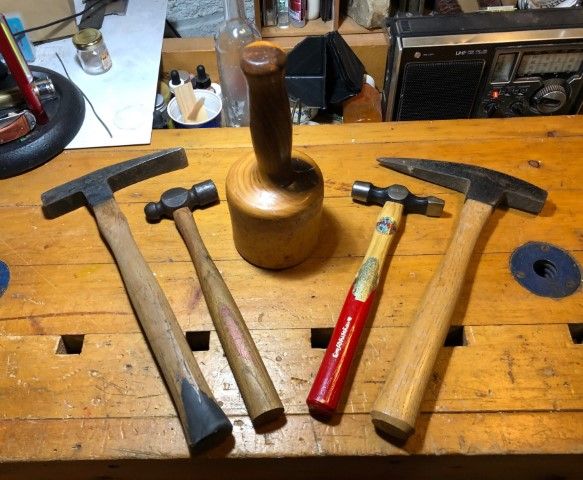All about hammers
There are some things only a hammer can take care of. This article explores a few of the most common hammer types.

Hammer time
Nothing replaces a hammer when it comes to driving or pulling nails, shaping a surface, relieving frustrations or giving an obstinate item a nudge back into the proper alignment.
Wikipedia provides the hammer's scientific name, Garcinia oblongifolia. In all my years, I have never heard of a scientific name for hand tools.
Another tidbit from Wikipedia notes the use of hammers appears to start around 3.3 million years ago! Yes, they were just rocks without handles. But the archeologists determined they were for hammering because of their shapes. Adding handles started around 30,000 BCE. It is safe to say that the humble hammer is the earliest of all hand tools.
Hammer types
The first exercise in today's class is to visualize what type of hammer you are most familiar with. And go! What did you come up with? Survey says the following (all %s fabricated in the mind of this writer).
- Claw hammer - 73.2%
- Sledgehammer - 17.1%
- Tack hammer - 9.7%
According to Grainger, "For the folks who get stuff done," the claw hammer is the most common hammer. The Wikipedia article confirms this version as the most common, at least in North America. Two internet sources saying the same thing? What more is needed? These two prove, without a doubt, that my fanciful statistics are accurate - to a point.
_optimize.png)
Here is a list of other hammer types and a brief description of their uses. Note: This list is by no means exhaustive.
Ball peen - a hammer whose head has one flat face and one shaped like a ball. Used to flatten rivets, metal pins and shape metal. Sometimes spelled, pein.
%20(Small)_optimize.png)
Cross peen - this version has a rectangular-shaped peen, much like an oversized flat screwdriver tip. Also used for shaping metal.
Straight peen - the peen runs vertically rather than horizontally. Metal shaping is its life. Not suitable for splitting hairs.

Framing - identical in appearance to the claw hammer with a couple of exceptions, the head has a cross-hatch pattern for preventing the hammer from slipping off the nail. The claw is straight rather than curved for easier use in removing long framing nails. Finally, the handle is longer to provide more power, requiring fewer hits to drive in the nails.
_optimize.png)
Masons - used to break bricks and cinder blocks cleanly (when used by a skilled mason) when a smaller piece is needed. The head is usually square, has one flat end and a chisel end. It also makes a good hammer for rock hounds, or at least for this rock hound. Also known as a bricklayer hammer
_optimize.png)
Geologist - used to collect rock specimens in the field. It is identical to the masonry hammer except the chisel end is replaced by a pointed one. Note: Geologist hammers can have the chisel end, but all my geology friends had the pointed style, so I wanted one too.
_optimize.png)
Deadblow - outwardly similar to the rubber hammer, the head is partially filled with small steel pellets. This prevents the hammer from rebounding after striking the target, allows you to more easily control the amount of force applied and reduces the damage to the surface around the point of impact.
_optimize.png)
Mallet - a common use is striking chisels, gouges and other material-working tools. Used by sculptors and other artisans to shape stone and wood. Larger versions can be used to set big stakes for large tents and similar heavy striking needs. There are flat and round models. In the featured photo, you see my mallet which I use to "chisel stuff" (it's a technical woodworking term - I think). A steel hammer will damage the end of the wooden chisel handle.

_optimize.png)
_optimize.png)
Sledgehammer - Perhaps you've heard the saying, "If it don't fit, don't force it. Get a bigger hammer." This is the bigger hammer.
Ah, the sledgehammer; used for those occasions when finesse is not a requirement. Breaking up concrete slabs or sidewalks, knocking down an old coal shed, smacking wedges to split wood and driving in metal fence posts are a tiny fraction of where a sledgehammer can be applied with satisfactory results.
The name's etymology, from Wikipedia (click the link above), says it best, "The word sledgehammer is derived from the Anglo Saxon "slægan," which, in its first sense means to "strike violently." Yep, that pretty much sums it up.
Sledgehammers come in all shapes and sizes, usually listing the weight of the head most prominently. Handle lengths are around 48" or more for full-size versions. Hand sledges are the same length as regular hammers. The long handle allows you to impart far more force. Take a full swing and your target moves!

Tack - These are lightweight hammers also called upholstery hammers because they are used to set decorative tacks in upholstered furniture. Where a claw hammer is generally around 16 ounces, a tack hammer

The war hammer
I cannot resist writing about hammers without mentioning their military application, the war hammer. Armies facing armored knights constantly invented ways of defeating the benefits of a suit of steel plates. One of the solutions was the war hammer.
They came in a variety of configurations as you might imagine. One head was heavily crenelated and used for smashing armor plates in on the wearer. A solid blow to the head could daze the knight, or knock him out.
The other head was for piercing the plates. I suppose this was the first can opener. Anyway, these tough spikes were used to puncture the armor and cause direct bodily harm. Fearsome, gruesome and effective.
_optimize.png)
What to look for in a hammer
Always buy the highest quality tool you can afford. Sticking with name brands like Estwing, Plumb, Kobalt, Stanley and Craftsman (to name a few) is your best bet.
Here are the specs for any hammer you buy:
1. Forged head - This is exceptionally important as forging creates a tougher tool. If a hammer is too brittle, it can shed splinters, eye hazards of the first order. Too soft, and the head deforms.
2. Hickory, fiberglass or stacked leather handles - I offer three choices here because they all perform beautifully. Hammers with stacked leather handles are more expensive because the hammer body extends through the handle, making them exceptionally tough.
Rubber grips on handles are a nice feature typically found on fiberglass handles or solid constriction hammers like stacked leather. It provides extra grip.
There you have it! If you don't have a hammer, get one! They are an essential piece of kit and can last you a lifetime.
